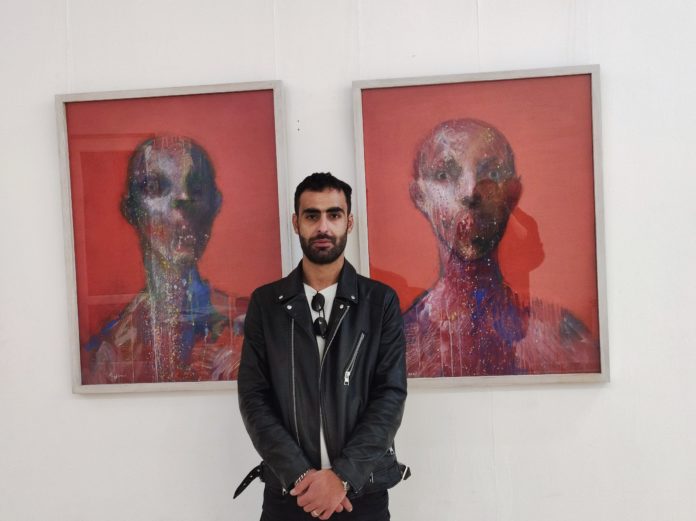
Guy Ghazanchyan
Pictures at Exhibition Raise Profound Issues
by Muriel Mirak-Weissbach
YEREVAN, DECEMBER 16, 2021 — Ambiguity lends a special quality to art. Not ambiguity as attempted deception, but as an invitation to explore what is unstated, merely hinted, or lends itself to multiple, even contradictory interpretations. An exhibition that opened on November 9 at the Yerevan Modern Art Museum is a perfect example. Guy Ghazanchyan is the artist and the title of the exhibition is “ԱԿԱՆատես” [Akanatehs], which contains a double meaning, through a play on words. In Armenian, this means “Witness” but if you isolate the first four letters, the word means “land mine.” Then a connecting vowel “ա” comes, followed by “տես” which is a word root meaning “see,” thus the title also implies “someone who saw the land mine.”
The exhibition is akin to a project, an action, an act of dedication. The concept, in the words of the artist, is depicted as follows: “А moment is like a verge, like a deafening sudden reality that questions the here and now. A frightening border between the Real and the Unreal, an attempt to stop time, to hear an unasked question, to stand at a dividing line, to see your own self and to realize the impossibility of accepting a given.”
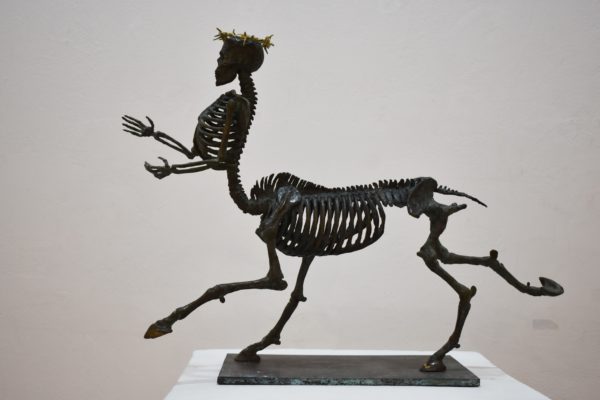
The Centaur
The day of the opening marked the first anniversary of the trilateral ceasefire agreement after the war in Artsakh, and the subsequent entry of Russian peacekeeping forces into the conflict zone. There are 44 items on display — paintings, an animation and a sculpture. The number of pieces exhibited was purely arbitrary; in fact, some works were removed during the show and, as all works appear under one title, no one even counted them. The first to take note of the number were the journalists. The 1st Public TV channel of Armenia, the country’s main public channel, carried a report on November 9, the day the exhibition opened, in the evening news. Up to that time no one (not even the artist) had pointed out the number of exhibited paintings. Everyone seemed surprised by such a coincidence: 44 paintings and the 44-day war.
Guy Ghazanchyan had started work on the project actually at the beginning of 2020, and, on reflection, thinks that he may not himself have fully realized what was emerging. Certain features of his earlier works, female images, aerial light compositions had vanished and given way to new concepts. It is hard to tell what triggered this change, but as the subsequent tragic developments unfolded, he followed the road chartered with new strength.
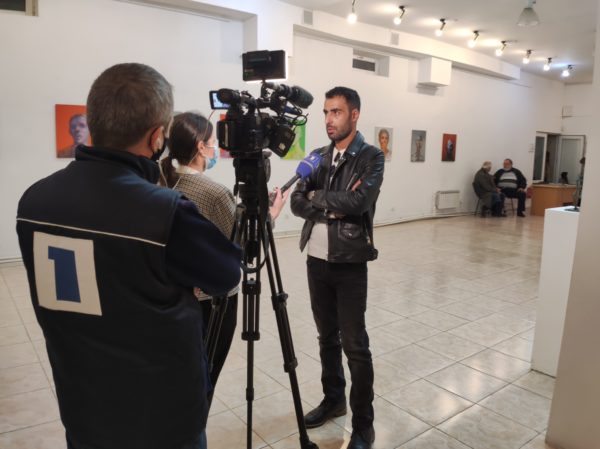
Guy Ghazanchyan
Portraits – of Whom?
With every new painting a new, horrifying image of a young man was born, with the frozen expression of an unanswered question on his face. The question, that, in Guy’s view, the beholder has to hear himself. We move from one portrait to the next, and despite the blurred, almost amorphous shape of each, we know that each is a distinct human being, an irreplaceable individual.
I was reminded of the photographs displayed on the walls of the Museum of Fallen Soldiers in Stepanakert, of the countless young Armenians who fought and died in the Karabakh war of the early 1990s. Under each black and white photo was a name and the dates of birth and death. I was one of many adults accompanying children from the graduating 5th grade class of St. Stephen’s Armenian Elementary School in Watertown. There, thanks to the plaques, we could identify each and every one; here in Guy Ghazanchyan’s portrait gallery, we can only pose the questions: Who? And from where? And how old (or, how young)? And, above all, why?
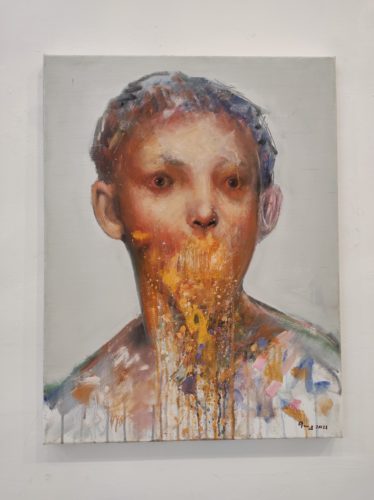
“Witness”
Identity, Reality and Idealism
As Daniela Grüninger, an art critic from AvestArt, noted, though the human “figures have volume,” they are enhanced by abstraction. Ghazanchyan’s figures “have individuality, personality, and give a deeper sense of reality; he does not have a stereotypical way of painting, which makes the works less ‘flat’ and superficial. His way of applying color expresses tension and suggests the idea of something much more masculine.” The art critic highlights Ghazanchyan’s “way of mixing reality, identity and idealism,” whereby “the figures seem real … they are not recognizable, but still they are unique, and all have an identity: he holds the viewer between these three worlds.” Indeed, this is the impact viewing the portraits had on me: one of suspension among three levels of existence. Who are they? Where do they come from? What do they represent ideally?
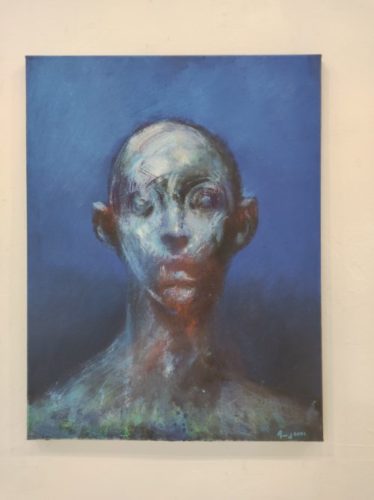
“Witness”
The animation projected onto the wall of the exhibition hall replicates the view of the series, but in accelerated time, one image immediately replaced by the next, and the sheer speed renders identification utterly impossible. Yet, we know, here too, that these faces are not statistics, but rather human beings. The sound track accompanying the rapid sequence of images enhances the overall atmosphere, transporting the viewer into another dimension. One is tempted to intervene and say, “No, stop, let me see who that is!” But in vain.
The sculpture “Centaur” embodies the absurdity of a war, with its predefined impossibility, unfairness, a war destined only to turn into horror, suffering and the wanton destruction of human life.
Extraordinary Reception
The exhibition “Witness” generated profound interest among professionals, which is of great importance to the artist and his family. Guy Ghazanchyan, 30 years old, represents the third generation of artists, his grandparents Nona Gabrielyan and Van Soghomonyan have been living and painting (and teaching) in Germany for thirty years. His parents, Lilit Soghomonyan and Gagik Ghazanchyan, are active in their Yerevan studio. (Guy has remarked that with such a family background, he can’t afford to be uninteresting.) Although this is not his first exhibition, it does represent a breakthrough. His mother, Lilit, admits she finds it very difficult to be unbiased while talking about her son’s work. Of course, she is very happy for and proud of everything he has accomplished, as any mother would be; but, as an artist and a specialist herself, she realizes how much he invested in this project, how he put his mind and heart into these works. She thinks as well that the work on this project probably helped him to survive everything they all had to go through.
Judging from the public reception, it has also helped others as well.
It was not only the community of artists and critics that applauded the artist’s work: just as important is the response that has come from the younger generation, the students at art colleges and academies in particular. They have come to the museum and stood in front of one portrait after the other, reflecting on what each image communicates; it is as if each face on the canvas were looking at you the visitor and telling his story, sharing his perception of everything that is happening. They all, together with their viewers, are united around one sensation, they experience together a fundamental emotional conflict: the inability, perceived impossibility to accept the reality before them, and yet the urgent need to stop the violence.
Questions are posed, simple answers are nowhere to be found.

Due to the extraordinary reception, the exhibition has been extended through December 20. For those unable to visit in person, the artist’s website is: https://guyghazanchyan.com/index. See also: https://www.youtube.com/watch?v=GYDdcCNHQm4
(Note: The “AKANates” / “Witness” exhibition-project was represented by Yerevan Modern Art Museum https://mamy.am and AvestArt Art Management Company, Zurich, Switzerland https://www.avestart.ch/artist/guy-ghazanchyan/ . Daniela Grüninger is an International Expert in Modern and Contemporary Art, Curator, former Head of the Geneva Office at Phillips Auction.
The author of this article extends her thanks to Lilit Soghomonyan and Guy Ghazanchyan for making the material, including photos, available, and to Sona Petrosyan, for her excellent translations into English.)